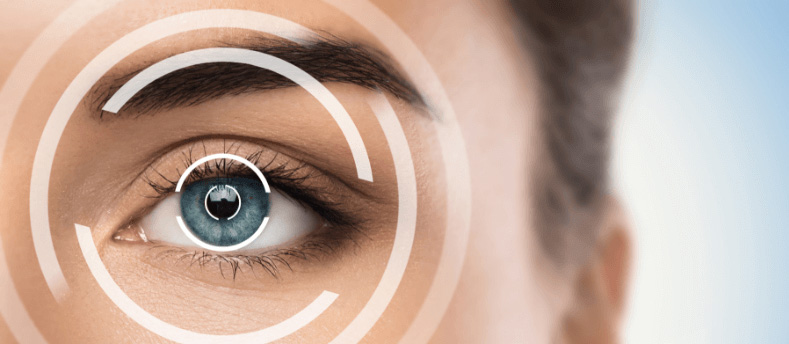Cataracts are the result of clouding of the eye’s natural lens and one of the most common vision impairments worldwide. Treatment for the condition typically involves surgery to remove the natural lens and replace it with an artificial intraocular lens (IOL). An estimated 20 million cataract surgery procedures are performed safely each year; it is the most common surgical performed in all of medicine.1,2 Modern advancements in surgical technology, technique, and intraocular lens implants further improve the safety and efficacy of the procedure.
WHAT CAUSES A CATARACT?
The most common cause of cataract formation is the natural aging process. Over time, the water and protein contents of the eye clump together, forming a cloudy area within the lens, interfering with the passage of light to the retina, and causing blurry or distorted vision.3-5 More than 50% of individuals in the United States alone who are 80 years or older have cataracts or have had cataract surgery.3 In some cases, other contributing factors such as eye injuries and comorbid conditions including diabetes and glaucoma affect the rate at which cataract formation occurs. Cataract formation can also occur from long-term use of steroid medications and due to some inherited genetic disorders.4
At first, individuals may not experience any symptoms associated with a cataract when it is mild.3 Over time, however, cataract can lead to vision loss. Cataract surgery becomes necessary when the cloudiness in the lens leads to a decrease in an individual’s quality of life because it significantly affects their ability to perform daily activities. Most individuals who are ready for cataract surgery complain of the following symptoms:3-5

- Blurred or hazy vision. Vision appears cloudy or foggy and objects appear less sharp, even with the aid of spectacle correction.
- Sensitivity to light. Patients with cataracts can experience sensitivity to bright lights as well as glare, which is especially noticeable while driving at night.
- Poor night vision. Difficulty seeing in low-light conditions can also become noticeable after the formation of a visually significant cataract. This can complicate night driving and navigating dimly lit areas, such as restaurants.
- Color distortion. A changing appearance of colors, such as dulling or fading. Distinguishing between shades also can become challenging as the cataract progresses.
- Double vision. Double vision that is not alleviated by closing one eye is another sign of a cataract requiring surgery.
- Frequent changes in eyeglass prescription. This is a good indication that the cataract is progressing and surgery is indicated.
WHAT IS CATARACT SURGERY?
During cataract surgery, the cloudy lens is removed from the eye. There are two surgical techniques, phacoemulsification and extracapsular cataract surgery.3 In the developed world, phacoemulsification is the most common technique. The procedure involves using an ultrasonic probe, inserted through a small incision, to break the cloudy lens into tiny fragments, which are then suctioned out of the eye gently. Extracapsular surgery can become necessary for more advanced cataracts. The procedure requires a larger incision than phacoemulsification because the cloudy lens is removed in one piece.
Regardless of the surgical technique, once the cloudy lens is removed, an artificial IOL is implanted.3-5 This synthetic lens is designed to restore clear vision by focusing light on the retina. IOLs are available in a variety of models that are designed to provide individuals with clear vision at one or more distances. Surgeons and other staff members discuss the available intraocular lens options with individuals during a preoperative consultation to determine the most suitable IOL for their individual needs.
WHAT ARE THE BENEFITS OF CATARACT SURGERY?
The main benefit of cataract surgery is the improvement of vision and quality of life. Removing the natural lens allows light to once again pass through the eye unimpeded, making vision more crisp and clear compared to vision through the cloudy lens.3-5 Improvements in visual acuity result from cataract removal. Patients often report a significant reduction in blurred vision and an improvement in completing daily tasks, including reading and driving.
During cataract surgery, other visual disturbances may be corrected, such as cylinder, which is also known as astigmatism. Specially designed IOLs, called toric lenses, are available to correct cylinder at the time of cataract surgery. This also leads to an improvement in visual quality and reduces the need for spectacle correction.
Many patients report an increased quality of life and independence after cataract surgery. It can help individuals to enjoy activities that they may have previously struggled with, including driving, watching TV, and partaking in hobbies.
CONCLUSION
Cataracts significantly impact an individuals’ quality of vision and daily life. Cataract surgery is the most common surgical procedure performed today,1,2 and the advancements in technology and technique make it an extremely safe procedure. Once the cloudy natural lens is removed, an artificial IOL is implanted to improve quality of vision.
- Kauh CY, Blachley TS, Lichter PR, et al. Geographic variation in the rate and timing of cataract surgery among US communities. JAMA Ophthalmol.2016;134:267–276.
- Gower EW, Lindsley K, Tulenko SE, et al. Perioperative antibiotics for prevention of acute endophthalmitis after cataract surgery. Cochrane Database Syst Rev.2017;2:CD006364.
- National Eye Institute. Facts about cataract. Accessed June 16, 2023. https://www.nei.nih.gov/learn-about-eye-health/eye-conditions-and-diseases/cataracts
- Mayo Clinic. Cataracts; Symptoms and causes. Accessed June 16, 2023. https://www.mayoclinic.org/diseases-conditions/cataracts/symptoms-causes/syc-20353790
- American Academy of Ophthalmology. Cataract surgery: what to expect. Accessed June 16, 2023. https://www.aao.org/eye-health/treatments/cataract-surgery-what-to-expect

